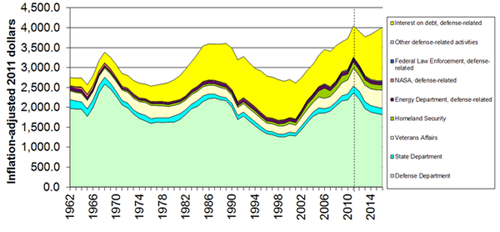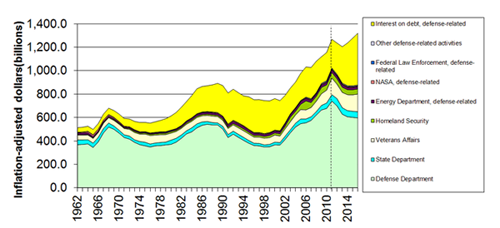Following the Peter Principle that “work expands to fill the time allotted for it,” so too does the eight-hundred pound gorilla of the Military Budget that hardly ever enters into the discussion of our inflated national debt expand, closing the door on infrastructure development, entitlements, educational debt and a myriad of other worthy causes. But let’s take a look at that ever Expanding U.S. Military Budget, from Wikipedia. Read as much of it as you can take.
“For the 2011 fiscal year, the president’s base budget of the Department of spending on “overseas contingency operations” brings the sum to $664.84 billion. That figure by 6/2013 is up to $866.3 billion and growing with the various wars in Libya, Somalia, Syria, and Turkey, so far.
“When the budget was signed into law on 28 October 2009, the final size of the Department of Defense’s budget was $680 billion, $16 billion more than President Obama had requested. An additional $37 billion supplemental bill to support the wars in Iraq and Afghanistan was expected to pass in the spring of 2010, but has been delayed by the House of Representatives after passing the Senate.
“Emergency and supplemental spending
“The recent invasions of Iraq and Afghanistan were largely funded through supplementary spending bills outside the federal budget, which are not included in the military budget figures listed below.[6] Starting in the fiscal year 2010, however, the wars in Iraq and Afghanistan were categorized as “overseas contingency operations”, and the budget is included in the federal budget.
“By the end of 2008, the U.S. had spent approximately $900 billion in direct costs on the wars in Iraq and Afghanistan. The government also incurred indirect costs, which include interests on additional debt and incremental costs, financed by the Veterans Administration, of caring for more than 33,000 wounded. Some experts estimate the indirect costs will eventually exceed the direct costs.[7] As of June 2011, the total cost of the wars was approximately $3.7 trillion.
“By title
“The federally budgeted (see below) military expenditure of the United States Department of Defense for fiscal year 2010, including the wars in Iraq and Afghanistan, is:
| “Components | Funding | Change, 2009 to 2010 |
| Operations and maintenance | $283.3 billion | +4.2% |
| Military Personnel | $154.2 billion | +5.0% |
| Procurement | $140.1 billion | −1.8% |
| Research, Development, Testing & Evaluation | $79.1 billion | +1.3% |
| Military Construction | $23.9 billion | +19.0% |
| Family Housing | $3.1 billion | −20.2% |
| “Total Spending | 683.7 billion | +3.0% |
“By entity
| Entity | 2010 Budget request | Percentage of Total | Notes |
| Army | $244.9 billion | 31.8% | In FY2011 $17,175,805,014.00 dollars [No source] was paid to retired Soldiers and Survivors, which is about 6.9% of the total Army Budget |
| Navy | $149.9 billion | 23.4% | excluding Marine Corps |
| Marine Corps | $29.0 billion | 4% | Total Budget taken allotted from Department of Navy |
| “Air Force | $170.6 billion | 22% | |
| Defense Intelligence | $80.1 billion | 3.3% | Because of classified nature, budget is an estimate and may not be the actual figure |
| Defense Wide Joint Activities | $118.7 billion | 15.5% |
“Programs spending more than $1.5 billion
“The Department of Defense’s FY 2011 $137.5 billion procurement and $77.2 billion RDT&E budget requests included several programs with more than $1.5 billion.
| “Program | 2011 Budget request | Change, 2010 to 2011 |
| F-35 Joint Strike Fighter | $11.4 billion | +2.1% |
| Ballistic Missile Defense (Aegis, THAAD, PAC-3) | $9.9 billion | +7.3% |
| Virginia class submarine | $5.4 billion | +28.0% |
| Brigade Combat Team Modernization | $3.2 billion | +21.8% |
| DDG 51 Burke-class Aegis Destroyer | $3.0 billion | +19.6% |
| P–8A Poseidon | $2.9 billion | −1.6% |
| V-22 Osprey | $2.8 billion | −6.5% |
| Carrier Replacement Program | $2.7 billion | +95.8% |
| F/A-18E/F Hornet | $2.0 billion | +17.4% |
| Predator and Reaper Unmanned Aerial System | $1.9 billion | +57.8% |
| Littoral combat ship | $1.8 billion | +12.5% |
| CVN Refueling and Complex Overhaul | $1.7 billion | −6.0% |
| Chemical Demilitarization | $1.6 billion | −7.0% |
| RQ-4 Global Hawk | $1.5 billion | +6.7% |
| Space-Based Infrared System | $1.5 billion | +54.4% |
“Other military-related expenditures
“Per-capita military spending 1962–2015 (inflation-adjusted 2011 dollars)
“Military spending 1962–2015 (inflation-adjusted 2011 dollars)
This does not include many military-related items that are outside of the Defense Department budget, such as nuclear weapons research, maintenance, cleanup, and production, which is in the Department of Energy budget, Veterans Affairs, the Treasury Department’s payments in pensions to military retirees and widows and their families, interest on debt incurred in past wars, or State Department financing of foreign arms sales and militarily-related development assistance. Neither does it include defense spending that is not military in nature, such as the Department of Homeland Security, counter-terrorism spending by the Federal Bureau of Investigation, and intelligence-gathering spending by NASA.
“Audit of Implementation of Budget for 2010
“The US Government Accountability Office (GAO) was unable to provide an audit opinion on the 2010 financial statements of the US Government because of ‘widespread material internal control weaknesses, significant uncertainties, and other limitations’. The GAO cited as the principal obstacle to its provision of an audit opinion ‘serious financial management problems at the Department of Defense that made its financial statements unauditable’.
“In FY 2010 six out of thirty-three DoD reporting entities received unqualified audit opinions.
“Chief Financial Officer and Under Secretary of Defense Robert F. Hale acknowledged enterprise-wide problems with systems and processes, while the DoD’s Inspector General reported ‘material internal control weaknesses . . . that affect the safeguarding of assets, proper use of funds, and impair the prevention and identification of fraud, waste, and abuse’. Further management discussion in the FY 2010 DoD Financial Report states ‘it is not feasible to deploy a vast number of accountants to manually reconcile our books’ and concludes that ‘although the financial statements are not auditable for FY 2010, the Department’s financial managers are meeting warfighter needs’.
“Audit of 2011 budget
“Again in 2011, the GAO could not “render an opinion on the 2011 consolidated financial statements of the federal government”, with a major obstacle again being “serious financial management problems at the Department of Defense (DOD) that made its financial statements unauditable”.
“In December 2011, the GAO found that “neither the Navy nor the Marine Corps have implemented effective processes for reconciling their FBWT.” According to the GAO, “An agency’s FBWT account is similar in concept to a corporate bank account. The difference is that instead of a cash balance, FBWT represents unexpended spending authority in appropriations.” In addition, “As of April 2011, there were more than $22 billion unmatched disbursements and collections affecting more than 10,000 lines of accounting.”
“Budget breakdown for 2012
“Support service contractors
Main article: Defense contractor
See also: List of United States defense contractors
“The role of support service contractors has increased since 2001 and in 2007 payments for contractor services exceeded investments in equipment for the armed forces for the first time. In the 2010 budget the support service contractors will be reduced from the current 39 percent of the workforce down to the pre-2001 level of 26 percent. In a Pentagon review of January 2011, service contractors were found to be “increasingly unaffordable. In fact, there are 110,000 private contractors in Afghanistan and the military does not exactly who is doing what.
“Military budget and total US federal spending
“World War II commenced a new era of permanency in the United States military budget. With the advent of the Cold War, the United States began to maintain a standing army and a permanent state of readiness for war that permanently elevated national defense expenditures. At the conclusion of his second term, President Eisenhower said in his Farewell Address:
“Our military organization today bears little relation to that known by any of my predecessors in peacetime, or indeed by the fighting men of World War II or Korea. Until the latest of our world conflicts, the United States had no armaments industry. American makers of plowshares could, with time and as required, make swords as well. But now we can no longer risk emergency improvisation of national defense; we have been compelled to create a permanent armaments industry of vast proportions. Added to this, three and a half million men and women are directly engaged in the defense establishment. We annually spend on military security more than the net income of all United States corporations.
“This conjunction of an immense military establishment and a large arms industry is new in the American experience. The total influence—economic, political, even spiritual—is felt in every city, every State house, every office of the Federal government. We recognize the imperative need for this development. Yet we must not fail to comprehend its grave implications. Our toil, resources and livelihood are all involved; so is the very structure of our society. In the councils of government, we must guard against the acquisition of unwarranted influence, whether sought or unsought, by the military industrial complex.
“The potential for the disastrous rise of misplaced power exists and will persist. We must never let the weight of this combination endanger our liberties or democratic processes. We should take nothing for granted. Only an alert and knowledgeable citizenry can compel the proper meshing of the huge industrial and military machinery of defense with our peaceful methods and goals, so that security and liberty may prosper together.
“Fiscal Year 2010 U.S. Federal Spending—Cash or Budget Basis
“The U.S. Department of Defense budget accounted in fiscal year 2010 for about 19% of the United States federal budgeted expenditures and 28% of estimated tax revenues. Including non-DOD expenditures, military spending was approximately 28–38% of budgeted expenditures and 42–57% of estimated tax revenues. According to the Congressional Budget Office, defense spending grew 9% annually on average from fiscal year 2000–2009.
“Because of constitutional limitations, military funding is appropriated in a discretionary spending account. (Such accounts permit government planners to have more flexibility to change spending each year, as opposed to mandatory spending accounts that mandate spending on programs in accordance with the law, outside of the budgetary process.) In recent years, discretionary spending as a whole has amounted to about one-third of total federal outlays. Department of Defense spending’s share of discretionary spending was 50.5% in 2003, and has risen to between 53% and 54% in recent years.
“For FY 2010, Department of Defense spending amounts to 4.7% of GDP. Because the U.S. GDP has risen over time, the military budget can rise in absolute terms while shrinking as a percentage of the GDP. For example, the Department of Defense budget is slated to be $664 billion in 2010 (including the cost of operations in Iraq and Afghanistan previously funded through supplementary budget legislation), higher than at any other point in American history, but still 1.1–1.4% lower as a percentage of GDP than the amount spent on military during the peak of Cold-War military spending in the late 1980s. Admiral Mike Mullen, former Chairman of the Joint Chiefs of Staff, has called four percent an “absolute floor” This calculation does not take into account some other military-related non-DOD spending, such as Veterans Affairs, Homeland Security, and interest paid on debt incurred in past wars, which has increased even as a percentage of the national GDP.”
So, there you have it from straight from the Gorilla’s mouth. Where and when it ends, only God knows—or more appropriately—Mammon . . . “In the New Testament, Mammon is material wealth or greed, most often personified as a deity, and sometimes included in the seven princes of Hell. Mammon may have also been a reference to Caesar whose tax coin claimed Caesar was a god, forcing Jews to break the first and second commandments to have no other gods, nor to have their graven images, or idols every time they paid taxes or tribute to Caesar. Mammon may have also been a reference to government, since the creator of money is government. Jesus was discussing two masters and the only other master besides God was Caesar.”
But, speaking for today, Mammon is that Eight Hundred Pound Gorilla, The Military Industrial Complex, making that enormous sucking sound that is money disappearing down the rabbit hole. It is what has crippled our economy with Fed easements for banks to big to fail, and oversight too small to keep them honest. In the words of Lloyd Blankfein, “We are doing God’s work,” or at least Mammon’s work. And as long as it goes on, that’s how long it will take the economy to crumble again.
So, whatever is Obama’s latest speech, siccing Eric Holder on the IRS or the NSA on the AP, persons of conscience will appear to whistle-blow the PRISM of surveillance agencies apart, outing them for what they are. And as long as we have the courage to not want to be buried in surveillance, but to hold on to our freedoms, whatever the cost, the Gorilla and Mammon will recede. Let it be written and remembered.
Jerry Mazza is a freelance writer and life-long resident of New York City. An EBook version of his book of poems “State Of Shock,” on 9/11 and its after effects is now available at Amazon.com and Barnesandnoble.com. He has also written hundreds of articles on politics and government as Associate Editor of Intrepid Report (formerly Online Journal). Reach him at gvmaz@verizon.net.






Good Column Jerry, especially the numbers. I didn’t know that. to that to those specifics.